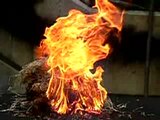Fire blanket
A fire blanket (also known as fire blanket) is a small extinguishing device and is mainly used to extinguish incipient fires .
The main extinguishing effect of a fire blanket, suffocation, is caused by the separation of oxygen and combustible material. Fire blankets are made from flame-retardant treated wool , also from glass fiber fabric or Nomex , formerly mainly from asbestos .
fitness
Fire blanket in action
A fire blanket can be used as an extinguishing agent in the event of a fire . According to more recent findings (under operational conditions, such as in restaurants, bakeries and the like in view of larger amounts of oil and cooking fat, e.g. in deep fryers), fire blankets for extinguishing fat fires - for which they were often kept in kitchens in the past - are only suitable to a limited extent :
The German accident insurance company BGN (professional association for food and hospitality) has carried out attempts to extinguish fat fires. It was found that the fire blankets ( wool , cotton , glass, Nomex and Kevlar fabrics ) are only suitable to a limited extent for extinguishing fat fires, as they can burn through if the "heat potential" is too high. Presumably the hot grease vapors condensed, causing the blankets to ignite ( wick effect ). During these tests it was also found that other extinguishing agents often suggested for fat fires in the past, e.g. B. powder or carbon dioxide, are only partially or not at all suitable.
In May 2017, the German Social Accident Insurance (DGUV) published information on the use of fire blankets, in which the use of fire blankets is not recommended for fat fires or for personal fires. In both cases, the current state of the art requires the use of a fire extinguisher, and for grease fires a special grease fire extinguisher.
standardization
| European Standard | EN 1869 |
|---|---|
| National standards | DIN EN 1869: 2001-01, OENORM EN 1869: 1997-04-01, SN EN 1869: 1997 |
| Area | Fire fighting |
| Regulates | Fire blankets |
| Brief description | |
| Latest edition | 1997 |
While it used to be called a fire blanket, the standardized German-language name according to EN 1869 is only a fire blanket . In practice, however, the old name is often used.
The DIN 14155, after her in Germany was standardized, is no longer valid for fire blankets. The same applies to ÖNORM F 1010, according to which it was standardized in Austria .
In Germany, a symbol that is regulated in accordance with ASR A1.3 and DIN EN ISO 7010 is provided for the identification of a place where a fire blanket is available . There is no standard for this in Austria. The notice can also be given with text panels.
Fire blanket container
Fire blanket (in the Rittner Bahn )
Large fire blankets
In March 2017, the Norwegian company Bridgehill presented a fire blanket about 10 m × 10 m in size, which unfolds in one direction, then can be stretched at two corners by two people and pulled over a burning car. As the fabric lies against the ground all around, the entry of fresh air is stopped and the fire is suffocated. Bridgehill recommends this car fire blanket (brannduken) for tunnels, parking garages and car ferries, as well as for forklift trucks with lithium batteries, each to isolate and extinguish a fire.
Individual evidence
- ↑ Use of fire blankets. DGUV , May 2017, accessed on January 26, 2020 .
- ↑ BGR 111: Working in kitchens - fire protection .
- ↑ BNG - New findings about fire blankets: They are unsuitable for grease fires .
- ^ Beuth Verlag - fire blankets; German version EN 1869: 1997
- ↑ News. Bridgehill AS, accessed June 23, 2019 .









